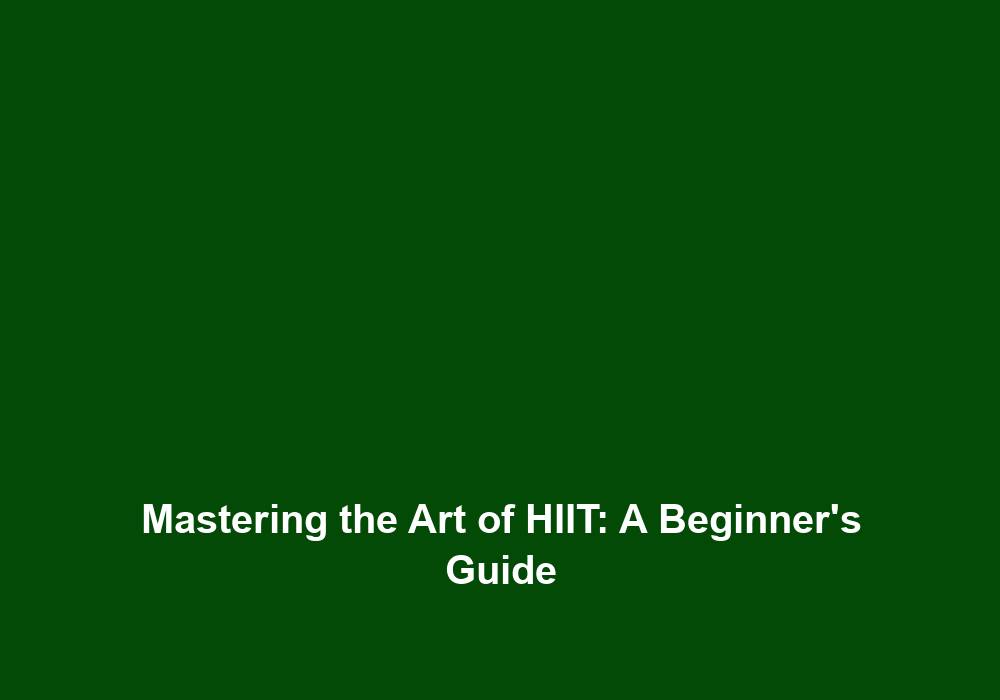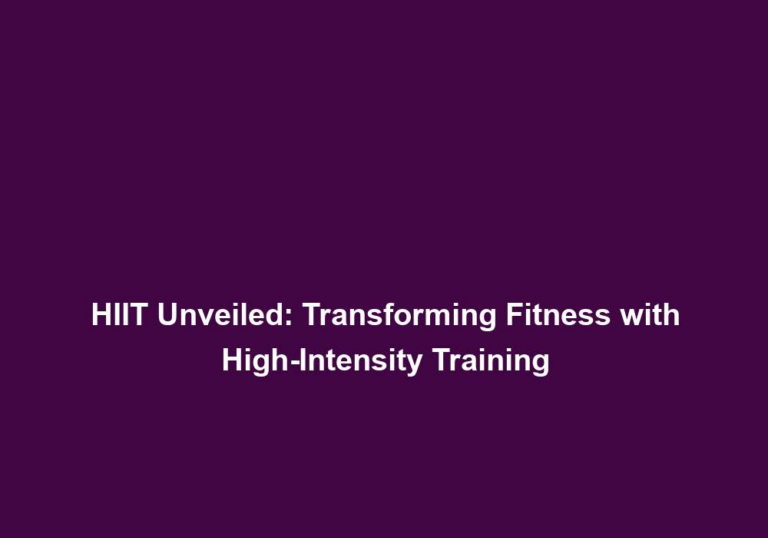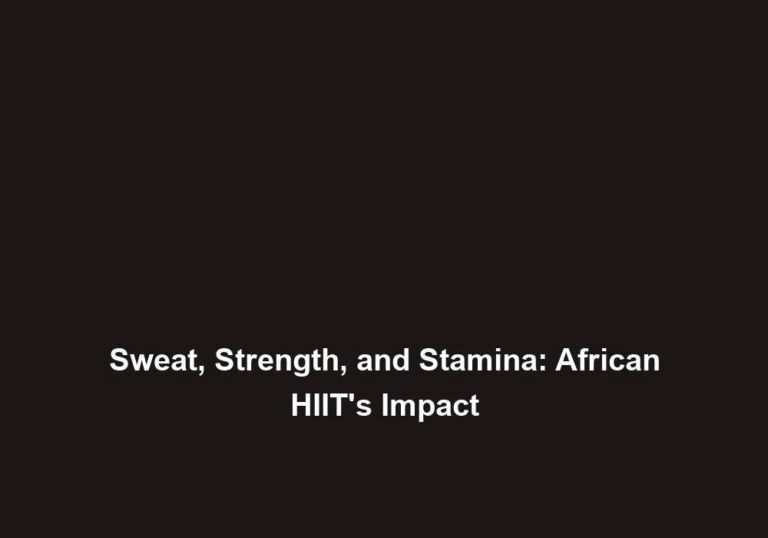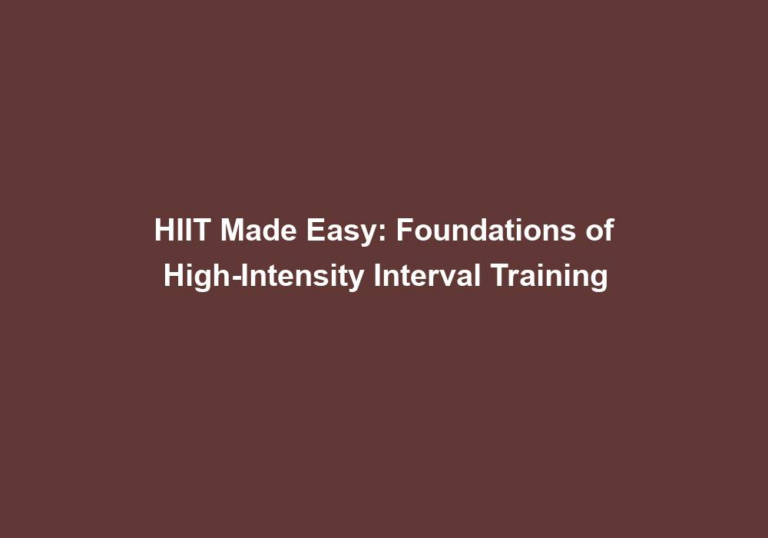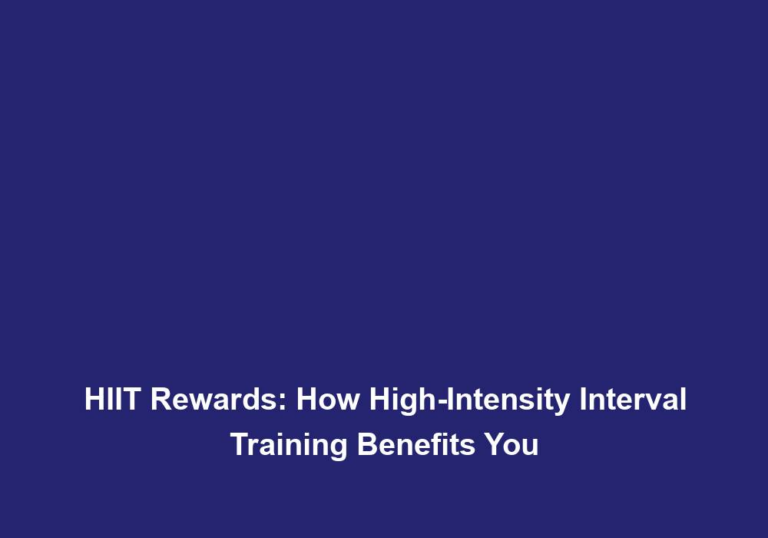Mastering the Art of HIIT: A Beginner’s Guide
High-Intensity Interval Training (HIIT) has gained immense popularity in recent years due to its effectiveness in improving fitness levels and burning fat. Whether you’re a fitness enthusiast or just starting your fitness journey, incorporating HIIT into your workout routine can help you achieve your goals faster. In this beginner’s guide, we will explore the art of HIIT, its benefits, and provide you with essential tips to get started.
Understanding HIIT
HIIT is a training technique that combines short, intense bursts of exercise with periods of rest or low-intensity recovery. The goal is to elevate your heart rate during the intense intervals, pushing your body to its limits, followed by brief recovery periods to catch your breath. This cycle is repeated for a specific duration, typically ranging from 10 to 30 minutes.
HIIT workouts can be structured in various ways, but they all involve alternating between high-intensity exercises and periods of rest or active recovery. Some common HIIT workout formats include Tabata, where you perform 20 seconds of intense exercise followed by 10 seconds of rest for a total of 4 minutes, and the 30-20-10 method, where you alternate between 30 seconds of moderate exercise, 20 seconds of intense exercise, and 10 seconds of rest.
Benefits of HIIT
-
Efficient and Time-Saving: HIIT workouts are known for their efficiency. Due to the high intensity, you can achieve more in a shorter amount of time compared to traditional workouts. A 15-20 minute HIIT session can be as effective as an hour-long moderate-intensity workout.
-
By engaging in HIIT, you can maximize calorie burn and improve cardiovascular fitness in a time-efficient manner. This makes it a great option for individuals with busy schedules who struggle to find time for longer workouts.
-
HIIT also offers the benefit of post-workout calorie burn, known as excess post-exercise oxygen consumption (EPOC). This means that even after your HIIT session is over, your body continues to burn calories at an elevated rate due to the oxygen debt created during the intense intervals.
-
-
Burns Fat: HIIT stimulates the production of human growth hormone (HGH) and increases your metabolic rate, leading to increased fat burning even after your workout is completed. It helps you shed excess body fat while preserving lean muscle mass.
-
The intense bursts of exercise in HIIT require large amounts of energy, which primarily comes from stored fat. This makes HIIT an effective method for reducing overall body fat percentage.
-
Furthermore, the increase in HGH production during HIIT not only promotes fat burning but also helps in building and toning muscles, resulting in a more sculpted physique.
-
-
Improves Cardiovascular Health: HIIT workouts challenge your cardiovascular system, improving your heart health and boosting your overall endurance. Regular HIIT sessions can lower blood pressure, reduce cholesterol levels, and enhance your cardiovascular fitness.
-
HIIT pushes your heart rate to its maximum during the intense intervals, effectively improving your heart’s ability to pump blood and increasing its overall efficiency.
-
The repeated cycle of intense exercise followed by recovery also helps in expanding the capacity of your lungs, allowing you to take in and utilize oxygen more effectively during physical activity.
-
-
Preserves Muscle Mass: Unlike steady-state cardio exercises that may lead to muscle loss, HIIT promotes muscle gain and retention. The intense intervals help stimulate muscle growth while burning fat, ensuring a lean and toned physique.
-
HIIT workouts incorporate resistance exercises and explosive movements, which activate multiple muscle groups simultaneously. This helps in building strength and muscle mass while burning calories.
-
Additionally, the short recovery periods in HIIT workouts prevent excessive muscle breakdown, preserving the hard-earned muscle mass and preventing muscle loss.
-
-
No Equipment Required: HIIT workouts can be performed with minimal or no equipment at all. This makes it accessible to everyone, regardless of their fitness level or gym access.
-
Bodyweight exercises such as squats, lunges, push-ups, and burpees can be incorporated into HIIT workouts, making it a convenient option for those who prefer to exercise at home or while traveling.
-
However, if you have access to equipment such as kettlebells, dumbbells, or resistance bands, you can include them in your HIIT routine to add an extra challenge and variety to your workouts.
-
Getting Started with HIIT
1. Consult with a Healthcare Professional
Before starting any new fitness regimen, it’s crucial to consult with a healthcare professional, especially if you have any underlying health conditions or concerns. They can provide guidance on your suitability for HIIT and ensure your safety during the workouts.
-
A healthcare professional can assess your overall health and fitness level, identify any potential risks, and provide personalized recommendations for incorporating HIIT into your routine.
-
This step is particularly important if you have any cardiovascular issues, joint problems, or a history of injuries. The professional can advise on modifications or alternatives to certain exercises to prevent further complications.
2. Warm-Up Properly
A proper warm-up is essential to prepare your body for the intensity of HIIT exercises. Spend 5-10 minutes engaging in light aerobic activities such as jogging, jumping jacks, or dynamic stretches to warm up your muscles and increase your heart rate gradually.
-
The warm-up phase increases blood flow to your muscles, raises your body temperature, and loosens up your joints, reducing the risk of injury during the high-intensity intervals.
-
It’s important to focus on dynamic stretches that mimic the movements you’ll be performing during the workout. This helps in activating the relevant muscle groups and improving your range of motion.
-
Some dynamic warm-up exercises you can incorporate include leg swings, arm circles, walking lunges, and hip rotations.
3. Choose Your HIIT Workout
There are numerous HIIT exercises and variations to choose from. You can opt for bodyweight exercises like burpees, jumping squats, or mountain climbers, or incorporate equipment such as kettlebells, dumbbells, or resistance bands. Select exercises that target different muscle groups and keep your routine diverse and engaging.
-
Bodyweight exercises are a great starting point for beginners as they require no equipment and can be modified to suit different fitness levels.
-
If you prefer using equipment, options like kettlebell swings, dumbbell thrusters, or resistance band rows can add resistance and intensity to your HIIT workouts.
-
It’s important to choose exercises that you enjoy and feel comfortable performing, as this will increase your adherence to the routine and make your workouts more enjoyable.
4. Determine Work and Rest Intervals
The work-to-rest ratio is a crucial aspect of HIIT. Ideally, aim for a 1:2 or 1:3 work-to-rest ratio. For example, if you perform a high-intensity exercise for 30 seconds, your recovery period should be 60-90 seconds. This allows for adequate recovery while challenging your body during the intense intervals.
-
The duration of the work and rest intervals can be adjusted based on your fitness level and goals. Beginners may start with longer rest periods to allow for sufficient recovery, while more advanced individuals can decrease the rest periods to increase the intensity.
-
It’s important to listen to your body during the workouts and adjust the intervals as needed. If you find that you’re unable to maintain proper form or your heart rate is not recovering adequately during the rest periods, consider increasing the rest time.
5. Start Slowly and Progress Gradually
If you’re new to HIIT, it’s vital to start at a comfortable intensity and gradually increase the difficulty level as your fitness improves. Begin with shorter workout durations, lower intensity intervals, and longer rest periods. As you build endurance and strength, you can progressively increase the intensity and decrease the rest periods.
-
Starting slowly helps in preventing injuries and allows your body to adapt to the demands of HIIT. It also reduces the risk of excessive muscle soreness and burnout.
-
Gradually increase the duration of your workouts by adding an extra interval or extending the length of each interval. Similarly, increase the intensity by incorporating more challenging exercises or increasing the resistance or weight used.
6. Listen to Your Body
While pushing yourself is important in HIIT, it’s equally important to listen to your body and avoid overexertion or injury. Pay attention to any pain or discomfort during workouts and adjust the intensity or modify exercises accordingly. Rest and recover adequately between sessions to allow your body to repair and adapt.
-
It’s normal to experience muscle fatigue and increased heart rate during HIIT workouts, but if you feel lightheaded, dizzy, or experience sharp pain, it’s important to stop exercising and seek medical attention if needed.
-
If a certain exercise or movement causes pain or discomfort, modify it or replace it with a more suitable alternative. It’s better to perform exercises correctly and safely rather than risking injury.
7. Stay Hydrated and Fuel Your Body
Proper hydration is crucial during HIIT workouts as you will be sweating heavily. Ensure you drink enough water before, during, and after your sessions to stay hydrated. Additionally, fuel your body with a balanced diet rich in lean protein, complex carbohydrates, and healthy fats to support your energy levels and recovery.
-
Hydration plays a vital role in maintaining your body’s temperature, lubricating your joints, and transporting nutrients throughout your body. Aim to drink water or a sports drink containing electrolytes before, during, and after your workouts.
-
In terms of nutrition, focus on consuming whole foods that provide a mix of macronutrients and micronutrients. Lean protein sources such as chicken, fish, tofu, or beans help in muscle repair and growth. Complex carbohydrates like whole grains, fruits, and vegetables provide sustained energy. Healthy fats from sources like avocados, nuts, and olive oil support hormone production and aid in nutrient absorption.
8. Incorporate Rest Days
HIIT workouts are intense and put stress on your body. It’s vital to incorporate rest days into your routine to allow your muscles to recover and prevent overtraining. Rest days promote muscle repair, reduce the risk of injury, and optimize your performance during subsequent workouts.
-
Rest days allow your body to replenish glycogen stores, repair muscle tissue, and reduce inflammation caused by intense exercise.
-
It’s important to strike a balance between challenging your body and giving it adequate time to recover. Aim for at least 1-2 rest days per week, during which you can engage in low-impact activities like stretching, yoga, or light cardio.
In conclusion, mastering the art of HIIT requires dedication, consistency, and a gradual progression. The combination of intense, short bursts of exercise followed by rest periods makes HIIT an effective training method for improving fitness, burning fat, and boosting overall health. By following the tips mentioned in this beginner’s guide, you can confidently incorporate HIIT into your fitness routine and reap its numerous benefits. Get ready to challenge yourself, exceed your limits, and embark on a rewarding fitness journey with HIIT!

